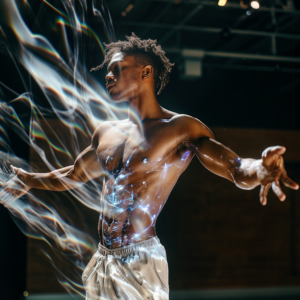COGNOSOMATIC DEFINITIONS
Cognosomatics
Cognosomatics is an interdisciplinary approach that explores the bidirectional relationship between cognitive processes and somatic (bodily) experiences. It seeks to understand how our thoughts, emotions, and identities shape our bodily actions and vice versa.
Cognosomatic Dance Praxis
This refers to a dance practice that is rooted in Cognosomatic principles. It considers how cognitive processes influence dance movements and how these movements, in turn, feedback into one’s cognitive understanding and identity.
AfriCognoSomatics
AfriCognoSomatics is a specialized branch of Cognosomatics that examines this cognitive-somatic relationship within the context of African heritage. It incorporates elements such as history, collective memory, cultural patterns, and systemic interactions that are specific to the Africana experience.
AfriCognoSomatic Dance Praxis
An AfriCognoSomatic Dance Praxis is a dance practice that specifically incorporates elements of African heritage, history, and philosophy. It focuses on how these elements interact with bodily movements and cognitive processes in a cyclical manner.
AfricanaCognoSomatics
AfricanaCognoSomatics is an expansive framework that combines both AfriCognoSomatics and AfriDiasporaCognoSomatics. It takes into account the experiences of people of African descent both within the continent and across the diaspora, exploring how racialized learning and body politics influence the cognitive-somatic relationship.
AfricanaCognoSomatic Dance Praxis
This is a dance practice that integrates both AfriCognoSomatic and AfriDiasporaCognoSomatic elements. It aims to explore the bidirectional relationship between the mind and body within the context of the broad Africana experience, including racialized learning and body politics.
AfriDiasporaCognoSomatics
AfriDiasporaCognoSomatics is another specialized branch, but it focuses on the experiences of the Africana diaspora. It deals with the complex layering of identities and experiences that occur when African heritage interacts with the cultures and histories of other lands.
AfriDiasporaCognoSomatic Dance Praxis
This dance praxis focuses on the Africana diasporic experience. It aims to understand how the convergence of multiple heritages and histories affects the body and cognitive processes, emphasizing the complex interactions and negotiations that occur within this space.
Each of these praxes and frameworks offer nuanced approaches to understanding the profound interconnection between mind, body, and cultural context. They serve as both academic paradigms and practical methodologies for exploring the intricate layers of identity, experience, and embodiment.
COGNOSOMATIC FOUNDATIONS
Cognosomatics expands the spectrum of embodied experience to include a two-directional interchange between our interior somatic experiences and our external actions and interactions. This term serves as a conceptual bridge between phenomenology and sociology, connecting the deeply personal with the undeniably communal. It underlines the symbiosis of experience and identity, pointing out that one cannot be understood or even realized without the other.
The Bidirectional Cycle of Experience and Identity
The unique aspect of Cognosomatics is its focus on the cyclic, ever-renewing nature of this relationship. Each action you take is both an expression of your identity and a catalyst for future experiences. This dynamic reciprocity perpetuates a cycle that is continuously evolving, not just forming our identity but also reforming it based on new experiences and perceptions. Whether you are conscious of it or not, you are always in a dance with the world—taking cues, giving signals, embodying memories, and anticipating futures.
A Layered Understanding: AfriCognoSomatics
When one introduces the Africana context, this bidirectional exchange becomes layered with additional dimensions—those of history, collective memory, cultural patterns, and systemic interactions. In this scenario, every movement, every utterance, and every thought is not just a bodily experience but an articulation steeped in a lineage that stretches back through generations and spans continents. The actions, movements, and even thoughts of Africana individuals are often shaped by a shared history and collective consciousness, which in turn influence how their actions are received by society. How these perceptions are internalized will continue to shape their individual identity and by extension, their bodily experiences.
For example, the mere act of an Africana person dancing could be a reclamation of heritage, a celebration of community, or an act of spiritual connectivity. But how that dance is perceived and received—either as an affirmation or a stereotype—feeds back into the dancer’s embodied experience, affecting future movements, future dances, and ultimately, their sense of self.
AfriDiasporaCognosomatics: A Confluence of Identities
In a diasporic setting, this intricate weave becomes even more textured. The body is the living canvas upon which multiple heritages and histories are drawn. It becomes a site where different worlds converge, adding further complexity to the Cognosomatic cycle. In this context, the Africana body isn’t just a passive recipient but an active negotiator of multiple identities, continuously navigating the seas of cultural understanding and misunderstanding, acceptance and exclusion.
Cognosomatics as a Discipline
As a field of study, Cognosomatics interrogates the layers and nuances of this cycle. It asks questions about how identity shapes bodily actions and vice versa, understanding this not as a linear process but as a spiral. Each experience feeds back into our cognitive realm, altering our next action, influencing our future experiences. In doing so, Cognosomatics offers both a lens and a language for examining the profound ways in which we are, quite literally, embodiments of our histories, architects of our futures, and narrators of our own evolving stories.
So, Cognosomatics is not merely academic inquiry; it is life in study, a reflective pool where philosophy meets practice, and where history, culture, and personal experience blend into a fluid dance of existence. It’s a methodology and an ethos, offering us tools to better understand our complex, multifaceted selves within the rich tapestry of collective human experience.
Introduction to CognoSomatics in Dance Praxis
CognoSomatics is not merely an academic concept but a holistic approach to understanding how we interact with the world. It serves as a bridge between the physical and metaphysical realms, establishing a bi-directional loop between cognition, embodiment, and action. In the context of dance, this approach probes beyond the steps and choreography to interrogate how cognitive processes, bodily experiences, and external stimuli intersect to shape both the dancer and the dance itself.
AfriCognoSomatic Dance Praxis: The Embodied Mind in an Africana Context
Definition:
AfriCognoSomatic Dance Praxis is a unique blend of cognitive and somatic experiences that occur within an African heritage context. It reflects a cyclical relationship between thought, movement, and interpretation, all deeply rooted in Africana philosophies and practices.
Imagine a dance that transcends the physicality of the body to become a conscious act of storytelling. Within the framework of AfriCognoSomatic Dance Praxis, each motion pours itself into the next, guided not just by rehearsed steps but by an intricate dialogue between thought and feeling. The dance then becomes a language in itself—a language through which one interprets racialized experiences, collective memory, and individual agency. The movement is simultaneously a manifestation of one’s corporeal and cognitive self, as well as a window into how the dancer navigates societal expectations and prejudices.
AfriDiasporaCognoSomatic Dance Praxis: The Multilayered Dance of Identity
Definition: AfriDiasporaCognoSomatic Dance Praxis explores the dance experience within the diasporic African context, integrating multiple cultural narratives and lived experiences through a lens of cognitive and bodily interaction.
Here, the dance floor becomes a space where various cultural rivers converge, each contributing its unique current to a larger, more complex stream of identity. The AfriDiasporaCognoSomatic dancer is a navigator of sorts, charting a course through the intricate confluence of ancestral legacies and contemporary experiences, both personal and collective. This approach to dance is a physical enactment of complex, intersecting identities, molded and remolded by a continually evolving dialogue between body, mind, and environment.
AfricanaCognoSomatic Praxis: An Integrative Approach
Definition: AfricanaCognoSomatic Dance Praxis amalgamates both AfriCognoSomatic and AfriDiasporaCognoSomatic perspectives. It serves as a comprehensive lens to explore how racialized learning, body politics, and African heritage collectively shape the dancer’s cognitive and bodily realms.
Envision a dancer poised at the intersection of time, space, and identity. Each movement is a nuanced dialogue with history, each pause an opportunity to assimilate, evaluate, and respond to external stimuli, be they an audience’s gaze, the rhythm of the music, or the collective emotional pulse of a community. This dancer does not merely ‘dance’; they embody a multidimensional philosophy that spans across racial, cultural, and even temporal boundaries. The dancer becomes a vessel through which diverse threads of thought, emotion, and history are woven into a singular yet multilayered tapestry of expression.
Implications for AfricanaCognoSomatic Practitioners
For practitioners committed to a deeper understanding of embodiment, identity, and performance, the AfricanaCognoSomatic approach offers an invaluable roadmap. The methodology not only elucidates how each dance move or pause can be an authentic manifestation of layered identities but also how these physical expressions serve as both a product and a producer of cognitive processes. It therefore creates an opportunity for dancers to engage in a cyclical, ever-evolving dialogue between their internal and external worlds.
CognoSomatic approaches in dance praxis offer a more nuanced understanding of the continuum that exists between the cognitive, corporeal, and contextual aspects of human experience. It extends an invitation to explore dance not just as a series of choreographed moves, but as a complex, interactive language that communicates the full spectrum of our humanity—from our deepest thoughts and feelings to our most immediate, physical realities. This dance becomes a canvas upon which our cognitive and somatic experiences blend, influencing and being influenced, in an eternal dance of becoming.

